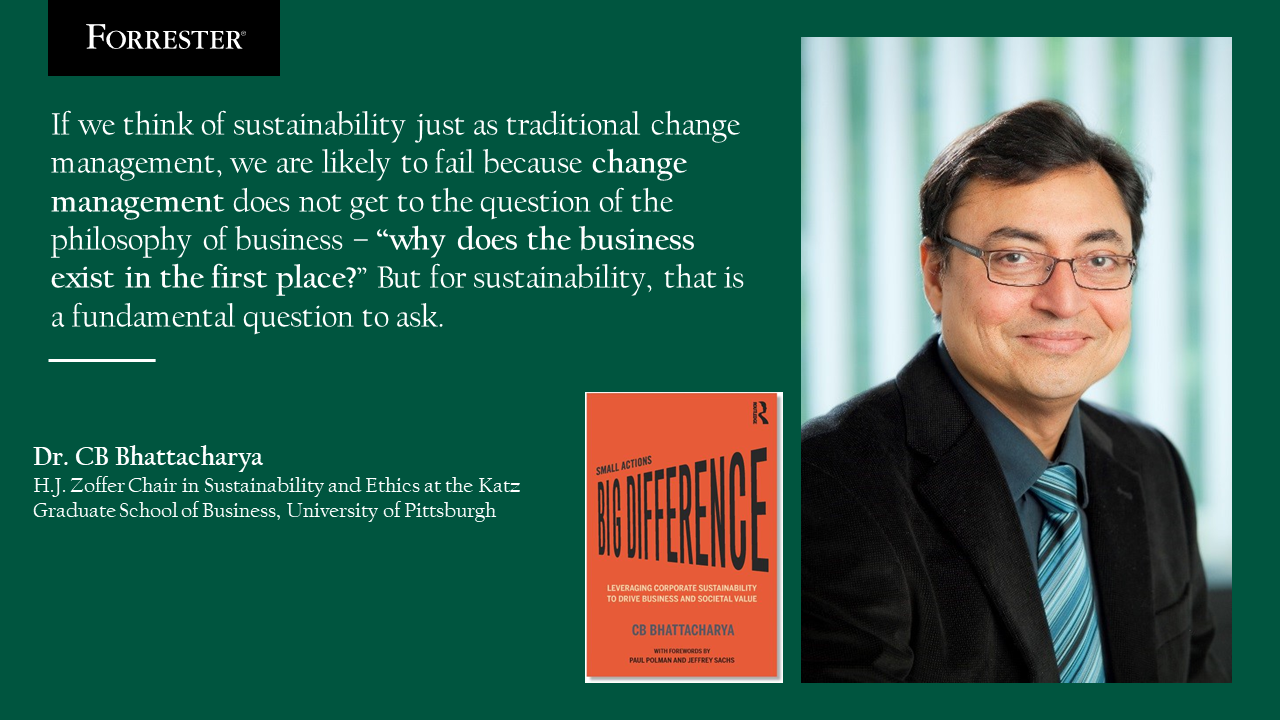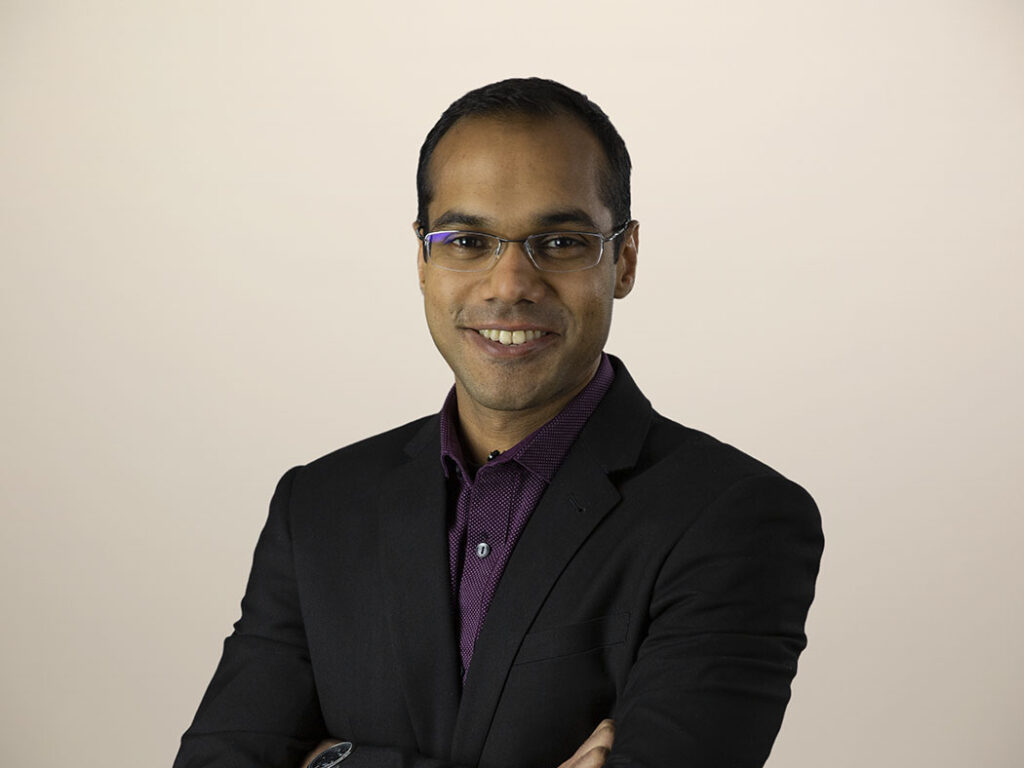Forr The Planet: Sustainability Interview Series — Dr. CB Bhattacharya, University Of Pittsburgh
 Photo by Abhinav Sunil
Photo by Abhinav Sunil
At the Katz Graduate School of Business, University of Pittsburgh, the H.J. Zoffer Chair in Sustainability and Ethics is CB Bhattacharya. He is a world-renowned expert in business strategy innovation aimed at increasing both business and social value.
He recently published his third book, “Small Actions Big Difference,” in which he connects sustainability to the theory and principles of psychological ownership and provides a stepped pathway to sustainability ownership.
In this interview, I chatted with him on how successful organizations address sustainability, change management, the role of the C-suite, findings in his book, and research on the topic of organizational psychology and sustainability ownership.
Abhijit: Drawing from your research on organizational sustainability and from your book, how do you advise an organization about the key steps that they should be considering when putting together a sustainability strategy?
CB:
Fundamentally, this is about what steps businesses can undertake to make the world a better place — to make our planet as well as our society healthier. The only way businesses can transform themselves to be more sustainable is by first defining purpose. And by purpose, I mean the answer to the question, “Why do we do what we do?” and not simply “What do we do?” So, if I’m in the business of making automobiles, why am I making automobiles? To what avail? And the answer must be invariably in terms of a societal benefit that the business provides. It cannot be that we want to make as much money as possible or sell as many cars as possible, which is, in fact, the narrative in many businesses even today. If a business does not define that purpose in terms of its societal impact and answer the “why,” it will never be sustainable. And it will never undertake tasks that make it imperative to integrate planetary concerns and people-related concerns into its business model.
The first step is thus to define that purpose and make sure that there is agreement among the top leadership of the company on what the business is actually about. Once you’ve defined that purpose, the next job that a business must do is to define some concrete goals for what it wants to address in the big field of sustainability. Every business does not necessarily have to prioritize carbon emissions. If I’m a consulting company, for example, reducing greenhouse gas emissions is not as much a top priority for me as it is for, let’s say, the largest cement maker in the world.
So, identify what priorities your company needs to pursue to be more sustainable. And here you must do a materiality analysis, which is a juxtaposition of what your stakeholders and company managers think are the most important things.
After these two stages, you incubate your sustainability plan. The next phase is what I call the launch phase: both to your internal stakeholders and subsequently to your external stakeholders. The priority is to launch your plan to your employees, who are your biggest allies in the business. Launching is a two-step process. First is to entice your employees or essentially to lure them to come aboard the Good Ship Sustainability, because some roles may be taking on more than what they may be doing day to day. It’s a hybrid appeal, a mix of the head and heart.
But it is not just enough to create willingness; it is equally important to create ability. You must invest in training and in management systems.
Overall, what you are doing here is empowering your employees and your stakeholders by lowering the costs of acting sustainably while increasing the benefits of acting sustainably.
Second is the entrench phase. This is when you make sustainability routine and second nature, like turning off the lights when we leave a room.
And for this, I propose three steps:
- First, demystify the progress that you are making on sustainability. The central idea behind transforming an organization to be sustainable is for your employees to take ownership of sustainability so that they don’t say, “Well, it’s not my problem. It’s someone else’s.” If you demystify the progress you make on sustainability and show employees the difference they’re making month after month, even day to day, the feeling of ownership intensifies.
- The second step is enlivening the culture of the organization, to make the culture vibrant and putting sustainability at the core of that culture. Here, there are multiple steps: Communication is absolutely key, plus cocreation — where you cocreate solutions with your employees — and celebration. Companies like Marks & Spencer have big Oscar-style, red carpet parties to call out store employees who do a fantastic job in sustainability.
- And then the final step is when we go from personal ownership to shared ownership or collective ownership, and what that means is to make sustainability not just our company’s problem, but the industry’s problem. No organization can fix all environmental problems individually, so we need everyone, including traditional competitors, to collaborate and work collectively on issues like deforestation.
Abhijit: In your work, have you seen this applicable to all industries? Or do you see this playing out in certain industries versus the others? What I mean is, for oil and gas firms or retail, consumer products or others, what is your experience in learning from these organizations?
CB:
In any industry, it is a question of the mindset of the leadership of the company and if the company is purpose driven. One example is of Enel, one of the largest electric utility companies in the world. It used to operate with coal, and now it is on the way to becoming a renewable energy powerhouse.
In my analysis, Enel is driven by a sense of purpose, which is why it stands in stark contrast to some of its competitors. Change takes a long time, but at Enel I’ve observed that this sense of ownership extends to the very far corners of its operations. I was in Chile working with Enel and viewing some of its geothermal plants, where I saw a palpable sense of ownership. Its headquarters is in Italy, so senior management from headquarters is not constantly looking over the shoulders of employees at remote locations. So that was fascinating to observe. Similarly, Unilever is a shining example of what you can do with your company and your employees if you are committed to actually leading with purpose. Paul Polman was the CEO at the time of my research, and his entire mantra was that you have to lead with purpose.
It really does depend on management’s philosophy of business. And this is where sustainability differs from change management. If we think of sustainability just as traditional change management, we are likely to fail because change management does not get to the question of the philosophy of business: “Why does the business exist in the first place?” But for sustainability, that is a fundamental question to ask.
Abhijit: To make the maximum impact on sustainability, how have you observed leaders trickle sustainability motivation down to each individual employee? Are sustainability goals brought out by the traditional C-level executives always, or should there be a chief sustainability officer (CSO)? Is that a key ingredient for success?
CB:
That is a good question since there is no silver bullet that fits all categories or use cases. But some of the things I have learned is that first, your CEO has to be purpose driven. If your CEO is more interested in his or her stock options and making sustainability somebody else’s problem, then obviously not a lot of good things will happen. And that’s not an organization structure question; that’s a character trait or an individual trait of a person, but it’s extremely important. Then there has to be the right team with the right CEO. What I learned from Paul Polman, for example, is that he was surrounded by a team full of “systems thinkers,” and the team he assembled could actually see aspects of these problems that linear thinkers are not able to see (e.g., what are the trends in the world and how might those trends impact a consumer products company or where society is headed overall?).
I have observed this in various configurations of chief sustainability officer roles. At Unilever, for example, I observed that it was the chief marketing officer who was also the chief sustainability officer at the time because they said we are a marketing company, so marketing and sustainability must go hand in hand for us.
In a beverage company, Coca-Cola European Partners, the second-largest bottler for Coca-Cola, the chief financial officer was the chief sustainability officer. For them, it’s about resource conservation.
So, I have observed that companies do have a chief sustainability officer as a role, but the CSO often will report to somebody below the CEO who has a line responsibility, for example, for marketing or finance.
In operations, Nestlé is a great example. The chief operations officer was, in fact, the chief sustainability officer at the time I was writing my book.
It does make sense that the person who has the ultimate responsibility of sustainability has some kind of capex responsibilities and can make decisions with regard to resources. Otherwise, they will have to keep running to somebody who does have that authority, and that will impair progress.
For many companies, the chief sustainability officer’s role is really a coordination function to make sure that everything with regard to sustainability — which can be measurement, reporting, or even employee awards — are all running smoothly and everybody is doing their part in sustainability.
Beyond that, successful organizations are always looking for internal ambassadors, which are not necessarily paid positions but sustainability volunteers if you will, who have the task of carrying the message through the organization.
Ambassadors are not part of the formal organizational structure, but every successful company that I’ve studied has these ambassadors. At Marks & Spencer, for example, it’s a volunteer role, and it helps employees find some meaning in their jobs.
These are some of the things that I have observed in terms of organization structures of successful companies.

Abhijit: What is your next interest academically in research around sustainability and organizational structures? What are the problems that you’re tackling currently?
CB:
In terms of my research, I’m trying to currently quantify the impact of a corporate purpose on employees’ sustainability behaviors. The anecdotal thing that I learned (and that I put in my book) is that companies that have a purpose and have managed to communicate that purpose to their employees are going to be more sustainable. I am exploring questions such as, “Can we show this with data or empirical models that support this view?” To this end, I have worked with quite a few companies that have programs on purpose and who have launched their purpose and so on.
I research employees of these companies and establish a link between having internalized this higher purpose of their company and the psychological mediator that drives sustainability-related behaviors. I find that those who have better internalized the purpose of the company take more ownership of sustainability, and, in turn, that ownership drives more sustainable behaviors in their work sphere, which could range from initiatives such as carpooling to work to talking to customers about replacing a piece of machinery that’s leaking oil.
We’re also finding that companies that give autonomy to their employees and have a sense of purpose are the companies that have employees with higher sustainable ownership. They exhibit more sustainable behaviors.
I lead the Center for Sustainable Business at the University of Pittsburgh. The center is also a hub for companies to come together. We created a forum called the Sustainable Business Forum where we debate and discuss issues that are germane to embedding sustainability into the DNA of the company.
A lot of my work is also trying to show that there is a better way to do business, which not only benefits the planet and its people, but that benefits the bottom line of businesses as well. So, I also have research that demonstrates that companies that do better on sustainability are actually the ones that are also more financially healthy in the long term. (Forrester’s research agrees.)
Abhijit: Thank you for your time and these insights, Dr. CB. Your book on the organizational philosophies needed for companies to be more sustainable is interesting, and we look forward to more of your research around employee psychology and sustainability.
CB: Thank you for this conversation!
*****
This interview was conducted by Forrester Analyst Abhijit Sunil in association with Researcher Renee Taylor. To learn more about Forrester’s research on technology sustainability, reach out to asunil@forrester.com or retaylor@forrester.com.
